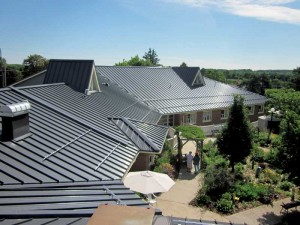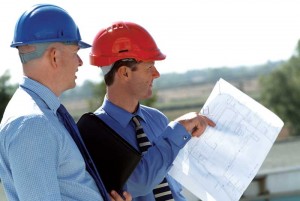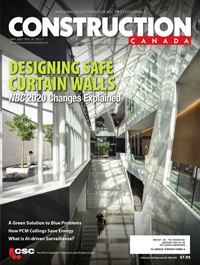Specifying service to ensure roof performance

Fire resistance
The manufacturer must certify the proposed roof system is tested and approved by a third-party agency to meet local and nationally recognized building codes for external fire resistance.
Drainage
Drainage shall be calculated for all roof areas to determine suitability of all plumbing and gutter accommodations (i.e. they are sized appropriately and can manage stormwater runoff).
Comprehensive documentation
Incorporating documentation requirements into the specification ensures the transparency of the performance expectations, thereby facilitating their achievement. Before project commencement, one may wish to specify the following documents be exchanged between all involved parties:
- a manufacturer’s technical data sheet for every category of roofing product specified;
- the manufacturer’s installation instructions for every category of roofing product specified, including specific recommendations and precautions;
- a list of all the warranty terms and conditions required by the manufacturer;
- manufacturer’s certifications verifying roof system approvals by any relevant testing agencies, such as Factory Mutual (FM) Global, Underwriters Laboratories of Canada (ULC), Warnock Hersey (WH), and other third-party testing organizations;
- material safety data sheets (MSDS) verifying the recommended handling procedures for all specified roofing products;
- a comprehensive written assessment, provided by the manufacturer, comparing available roofing solutions and validating the selected system best meets the project requirements; and
- written certification from the manufacturer that the applicator is currently authorized to install the specified roof system.
Installer qualifications
As noted, a field service specification for roofing should indicate the installer has been certified by the manufacturer to install the specified roof system. It is not unreasonable to incorporate additional stipulations designed to protect the owner from financially unstable contractors (e.g. to incorporate specific bonding requirements, worker safety expectations, field supervision, and staffing expectations) into a service specification. One may also wish to require documentation of the contractor’s experience with projects of a similar nature and within a specified geographic area using the specified roof system to ensure the recommended system is appropriate for conditions similar to those of the current project.
Product substitutions
Once a field service section has been incorporated into the roofing specification, it is important to verify all products proposed as equal to those specified be confirmed in MasterFormat Section 01 43 33 to be ‘as equal’ in relation to both the material and service requirements specified. Proposed substitutions must be accompanied by a signed and sealed certification by a professional engineer (certified by the province in which the installation is to take place), verifying the recommended substitutions are compliant with both the material and field service requirements of the roofing specification.

Co-ordination meetings
There are specific milestones throughout a project that require precise communication and thorough documentation. A field service specification enables one to require those meeting-related processes most likely to ensure effective co-ordination and success.
The pre-construction meeting is essential for communicating to all parties the goals of the roofing project and the procedures required to achieve them. Minimally, the pre-construction meeting should be attended by the manufacturer’s representative(s) for any roofing materials deemed essential to the project, the contractor(s), and the owner’s representatives. The following items should be reviewed and documented:
- plans and specifications for the work to be performed;
- safety and mobilization plans and concerns;
- all submittal material, inspection, and testing requirements; and
- general expectations of installation procedures.
The post-construction meeting is equally important––its function is to validate the quality of the completed work. It is reasonable to specify the warranty, owner’s care and maintenance manual, and any other close-out documents be exchanged at this meeting.
The final inspection/co-ordination meeting is the last opportunity to review the work performed. Service specification requirements in regard to this critical meeting might include:
- attendance by the contractor, roofing system manufacturer’s representative, and a representative of the building owner;
- a mandatory walk of the roof to inspect the details of the building perimeter, flashings and roof penetrations, parapets, curbs, and rooftop equipment; and
- creation of a deficiency list of items requiring correction or completion, and a related report specifying action items, responsible parties, and deadlines.
Clarifying meeting expectations that are a field services specification will help eliminate change orders due to miscommunication while minimizing liability through clearly articulated objectives and methodologies.

Other considerations
From time to time, other assurances of quality and workmanship may be necessary to achieve the goals of a building’s architect and/or owner. For example, one may wish to require certification that materials:
- were manufactured in North America;
- have been tested to meet special conditions (e.g. chemical effluents or saltwater environments) encountered on the specific roof; and
- were manufactured in facilities using International Organization for Standardization (ISO) 9001-2008, Quality Management Systems–Requirements.
Conclusion
Unlike other mission-critical construction systems, the service requirements for roofing specifications have been historically integrated into the specification sections that define material requirements and installation methods.
By opting to highlight the specific service expectations under MasterFormat Section 01 43 33, architects and building owners will increase the likelihood of successful roofing projects that realize their long-term design and performance objectives.
Michael D. Huber, PE, is the director of engineering for Garland. With a background in structural, environmental, and geotechnical engineering, he has been a professional engineer since 1994. Huber is a popular presenter of an American Institute of Architects (AIA)-accredited course on the engineering and design of metal roof systems. He holds a bachelor’s degree in engineering physics from Miami University and one in civil engineering from Purdue University. Huber can be reached via e-mail at mhuber@garlandind.com.







